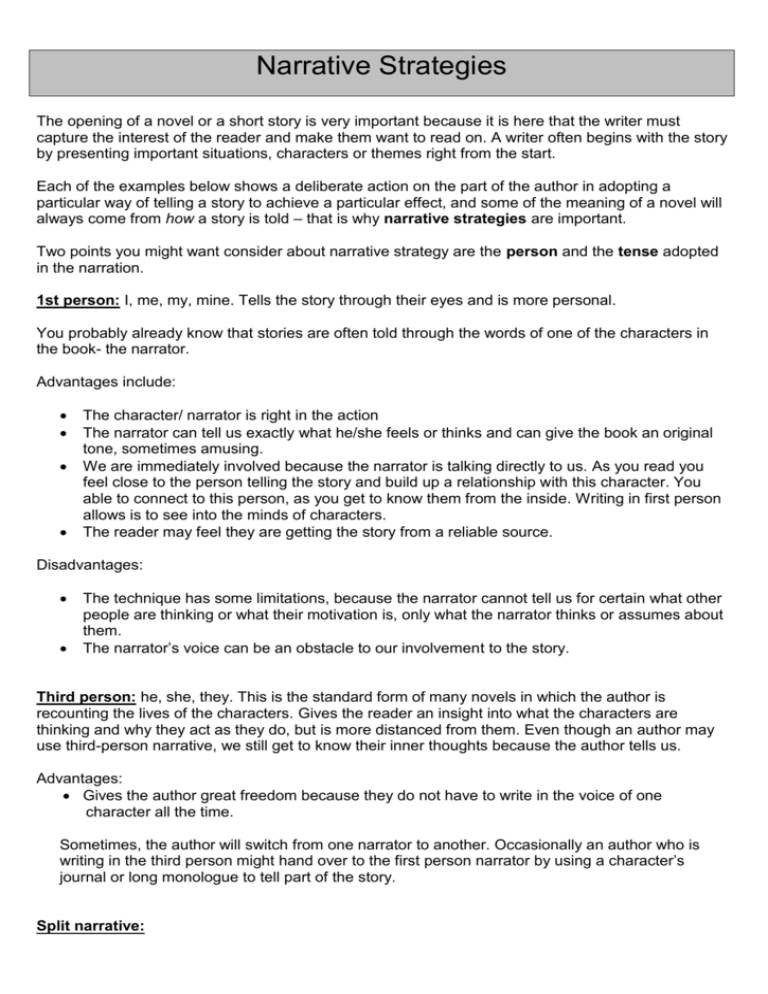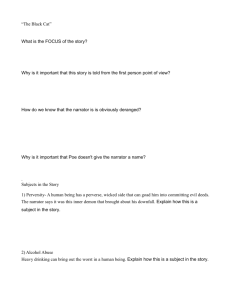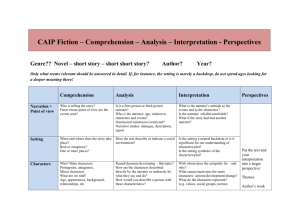Narrative Strategie - Hannah Tyreman`s GCSE English
advertisement

Narrative Strategies The opening of a novel or a short story is very important because it is here that the writer must capture the interest of the reader and make them want to read on. A writer often begins with the story by presenting important situations, characters or themes right from the start. Each of the examples below shows a deliberate action on the part of the author in adopting a particular way of telling a story to achieve a particular effect, and some of the meaning of a novel will always come from how a story is told – that is why narrative strategies are important. Two points you might want consider about narrative strategy are the person and the tense adopted in the narration. 1st person: I, me, my, mine. Tells the story through their eyes and is more personal. You probably already know that stories are often told through the words of one of the characters in the book- the narrator. Advantages include: The character/ narrator is right in the action The narrator can tell us exactly what he/she feels or thinks and can give the book an original tone, sometimes amusing. We are immediately involved because the narrator is talking directly to us. As you read you feel close to the person telling the story and build up a relationship with this character. You able to connect to this person, as you get to know them from the inside. Writing in first person allows is to see into the minds of characters. The reader may feel they are getting the story from a reliable source. Disadvantages: The technique has some limitations, because the narrator cannot tell us for certain what other people are thinking or what their motivation is, only what the narrator thinks or assumes about them. The narrator’s voice can be an obstacle to our involvement to the story. Third person: he, she, they. This is the standard form of many novels in which the author is recounting the lives of the characters. Gives the reader an insight into what the characters are thinking and why they act as they do, but is more distanced from them. Even though an author may use third-person narrative, we still get to know their inner thoughts because the author tells us. Advantages: Gives the author great freedom because they do not have to write in the voice of one character all the time. Sometimes, the author will switch from one narrator to another. Occasionally an author who is writing in the third person might hand over to the first person narrator by using a character’s journal or long monologue to tell part of the story. Split narrative: The narrator tells the story through the eyes and voice of more than one speaker. Advantages: The reader always knows more than what the characters know- a form of dramatic irony. Vary the perspective on a situation or event, so that you see more than one event, and therefore more than one viewpoint. Two sides to the story. Consider this extract from ‘Miss Smilla’s Feelings for Snow’ by Peter Hoeg. ‘Now they are lowering him into the ground. The coffin is made of dark wood, it looks so small, and there is already a layer of snow on it. The flakes are no bigger than feathers, and that’s the way the snow is, it’s not necessarily cold. What is happening at this moment is that the heavens are weeping for Isaiah, and the tears are running into a down of frost that is covering him up. In this way the universe is pulling an eiderdown over him, so that he will never again feel the cold.’ 1) What tense is the narrator writing in? Present, describing what is happening now. 2) What effect does this have on the reader? It gives the writing a special urgency and immediacy. Here are the openings from different novels. Read through them carefully and think about what you learn from each and what effect is created. You might want to consider: Who the narrator is What you learn about the characters What setting or context is created. What you notice about the writer’s style Whether it makes you want to read on, and why A Kestrel For a Knave by Barry Hines There were no curtains up. The window was a hard edged block the colour of the night sky. Inside the bedroom the darkness was of a gritty texture. The wardrobe and the bed were blurred shapes in the darkness. Silence. Billy moved over, towards the outside of the bed. Jud moved with him, leaving one side of the bed empty. He snorted and rubbed his nose. Billy whimpered. They settled. Wind whipped the window and swept along the wall outside. Narrative Strategy In A Kestrel For a Knave the author invites us to watch two brothers as they sleep. This unrealistic situation is offered to us by the author who can describe what goes on in the bedroom whilst also taking us outside as the wind ‘swept along the wall outside.’ Basically, the author in this strategy is all-seeing: he or she knows everything and is therefore referred to as the omniscient narrator. The extract is also written in the past tense which reinforces the power of the author. In other words, these events have already happened and the author knows, but we do not. The author has prior knowledge of the events as a whole but we, as readers, can only interpret events as we know them so far. Great Expectations by Charles Dickens My father’s name being Pirrip, and my Christian name Philip, my infant tongue could make of both names nothing longer or more explicit than Pip. I gave Pirrip as my father’s name, on the authority of his tombstone and my sister – Mrs Joe Gargery, who married the blacksmith. As I never saw my father or mother, and never saw any likeness of either of them (for their days were long before the days of photographs), my first fancies regarding what they were like, were unreasonably derived from their tombstones. The shape of the letters on my father’s gave me an odd idea that he was a square, stout, dark man with curly black hair. From the character and turn of the inscription, ‘Also Georgina Wife of the Above,’ I drew a childish conclusion that my mother was freckled and sickly. To five little stone lozenges, each about a foot and a half long, which were arranged in a neat row beside their grave, and were sacred to the memory of five little brothers of mine – who gave up trying to get a living, exceedingly early in that universal struggle – I am indebted for a belief I religiously entertained that they had all been born on their backs with their hands in their trouser pockets, and had never taken them out in this state of existence. Narrative Strategy In this passage from Great Expectations Charles Dickens writes in the past tense but the narration is now in the first person. The teller of the story in this case is someone directly involved in events, rather than someone who is standing outside. Pip here is telling his own story and will obviously do so with more passion that perhaps would be the case otherwise. The author’s decision to write as an involved narrator creates a different kind of relationship with the reader. We know something about the narrator and this puts us in a stronger position than when following an omniscient narrator. With first person narration our interpretation of events is bound up in our growing knowledge of his / her personality. As we learn of the narrator’s personality, and that they themselves may convey their own personal feelings concerning the unfolding events, this type of story-teller is sometimes know as an unreliable narrator. In some ways the reader becomes more active because we are no longer merely accepting the authority of an omniscient narrator, but we are perhaps thinking more carefully about the word of the narrator. Another feature of this kind of narration is that the narrator cannot go inside the head of other characters, so is obviously is seeing things from his her own point of view. Your Shoes by Michele Roberts I thought I knew you as well as I know this house. No secret places, no hidey holes, nothing in you I couldn’t see. Now I realise how you kept yourself from me, how I didn’t really know you at all. You’re not here any longer so how can I speak to you? You can’t speak to someone who isn’t there. Only mad people speak to a chest of drawers, a bed that hasn’t been slept in for weeks. Someone half mad, with grief that is, might pick up a shoe from the rug and hold it like a baby. Someone like me might do that. As if the shoe might still be warm and give me a clue to where you’ve gone. One shoe pointed in fact towards the bedroom window, the view of the garden, and the other one pointed towards the door. They wanted to get out, to get away, just like you did. I made them neat again. I stowed them in the wardrobe. Just in case. I locked the wardrobe door on those rebellious shoes. They could be like me and grieve in the darkness. For a bit. Then I let them out. I’m not cruel. But they’ve got to learn, haven’t they. Kids these days. …If you opened the door now and came in you’d find me here in your room. I’m lying curled up in the middle of the bed, on top of the duvet. I’ve drawn the curtains because the light hurts my eyes. It’s already lunchtime but I don’t want to face the fridge… Narrative Strategy In Your Shoes the narrator seems to speaking to her daughter despite the fact that her daughter isn’t there. She emphasises the madness of that action herself and it helps us to appreciate the intensity of her grief. As readers we are placed in a very intimate relationship with the woman, since we are overhearing something that is intensely painful and almost embarrassingly private. The sense that we are intruding upon her private grief is part of the impact of the story In fact, the woman in the story is writing to her absent daughter, even though she has no address to which she can post her letter, but by then the relationship with the reader is already established and the sense of reading someone else’s private mail is almost as uncomfortable as overhearing their thoughts. The sense of privacy is emphasised by the way she speaks; the kinds of things she says are the things she would normally say only to her daughter, and certainly not to a complete stranger. The importance of the relationship with the reader in moulding the impact of the story cannot be underestimated. The sense of the woman’s utter isolation comes from the act of writing to someone who cannot receive the communication. She writes but there is no reader; she speaks but there is no listener – except you, and you shouldn’t be reading or listening! To Kill a Mockingbird by Harper Lee When he was nearly thirteen my brother Jem got his arm badly broken at the elbow. When it healed, and Jem’s fears of never being able to play football were assuaged, he was seldom self-conscious about his injury. His left arm was somewhat sharper than his right; when he stood or walked, the back of his hand was at right-angles to his body, his thumb paralleled to his thigh. He couldn’t have cared less, so long as he could pass and punt. When enough years had gone by to enable us to look back on them, we sometimes discussed the events leading to his accident. I maintain that the Ewells started it all, but Jem, who was four years my senior, said it started long before that. He said it began the summer Dill came to us, when Dill first gave us the idea of making Boo Radley com out. I said if he wanted to take a broad view of the thing, it really began with Andrew Jackson. If General Jackson hadn’t run the Creeks up the creek, Simon Finch would never have paddled up the Alabama, and where would we be if he hadn’t? We were far too old to settle an argument with a fistfight, so we consulted Atticus. Our father said we were both right. Narrative Strategy – To Kill a Mockingbird The story is told from Scout's viewpoint. It is written in the first person. This means that Scout uses the pronouns I, me and the possessives my, mine to refer to herself. She does not confine the narrative to things that she has directly experienced - for example she recounts stories from the history of Simon Finch, and repeats what other people tell her. Using a child as a narrator can have a significant effect on the relationship with the reader. This can be seen in To Kill a Mockingbird , a novel set amongst people who have lived with racial inequality for so long that is has become so acceptable that people don’t even see it any more. A child narrator has not lived long enough to acquire prejudice and is still able to accept people at face value without reference to their colour. The simplicity of the narrator’s moral judgements shows up the hypocrisy of adult attitudes most effectively. Narrator’s age at the time of the story is important. It allows the novel to take advantage of 2 diff. View points which are years apart. Narrated by the adult Scout, looking back on her childhood feelings at the time the story is set. Story has a sense of autobiography. An older person is retelling the incidents from her childhood. The Color Purple by Alice Walker You better not never tell nobody but God. It’d kill your mammy. Dear God, I am fourteen years old. I am – I have always been a good girl. Maybe you can give me a sign letting me know what is happening to me. Last spring after little Lucious come I heard them fussing. He was pulling on her arm. She say It too soon, Fonso, I ain’t well . Finally he leave her alone. A week go by, he pulling on her arm again. She say Naw I ain’t gonna. Can’t you see I’m already half dead, an all of these children. She went to visit her sister doctor over Macon. Left me to see after the others. He never had a kine word to say to me. Just say You gonna do what your mammy wouldn’t. Narrative Strategy A similar effect to A Kestrel For a Knave is evident in the novel The Color Purple. Here a fourteen year old child is the narrator and she is being abused by her father. As she has no-one else to turn to, she writes letters to God, and the entire novel reaches us in the form of letters. As with Your Shoes the act of writing letters which can’t be sent becomes a powerful signal of terrible isolation and desperation. Later in the novel, other letters, from her sister, are discovered and this introduces a note of hope. There is a sense of connection with another human being which softens the sense of isolation found at the start. The sense of isolation in The Color Purple is a major part of the meaning but it doesn’t come to us because a character has said, ‘I’m isolated’ – rather, it is a sense that reaches us because the author has decided to tell the story in a particular way.








